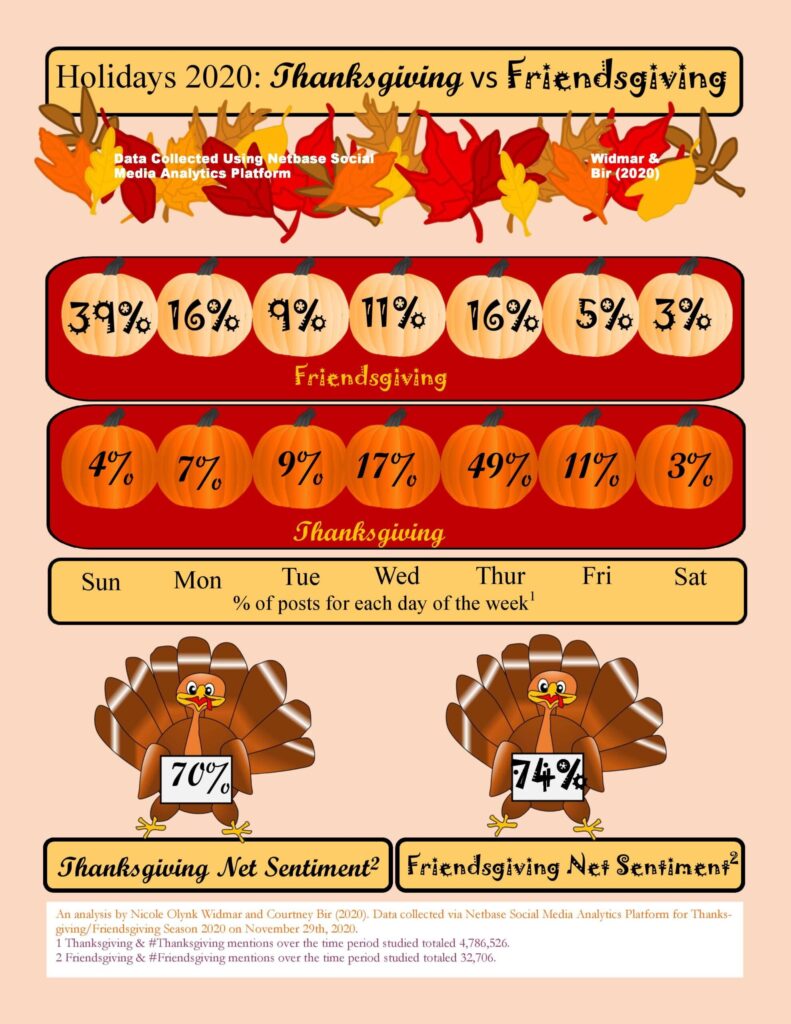Authors: Dr. Nicole Olynk Widmar, Associate Head and Professor, Purdue University Department of Agricultural Economics
Dr. Courtney Bir, Department of Agricultural Economics, Oklahoma State University

Thanksgiving Day, according to Merriam-Webster, is “a day appointed for giving thanks for divine goodness”. The legal holiday in the U.S. was formally appointed to the fourth Thursday of November in 1941, although the origins of the U.S. celebration and feast date back to 1621.
Friendsgiving appears as a “Word We’re Watching” in Merriam-Webster and is dubbed as a way to “escape your family and celebrate with friends”. Merriam-Webster claims the earliest print of the word is 2007, although admits it floated around in spoken English before then. Counter to what many people think, Friendsgiving did not originate on the TV show “Friends”. The term rose to prominence in 2011 when Bailey’s Irish Cream used the word in an ad campaign.
While it was a trend that was accelerating before now, one cannot deny the ‘mass movement of our lives into an online space that occurred in 2020 in response to the (ongoing) COVID-19 pandemic. We recently investigated #Halloween 2020, and now we’re revisiting an agricultural holiday staple (turkey, anyone?) we previously investigated in 2018 when we were just getting started in online media analytics.

Download a pdf of this infographic.
While survey data, publicly available agricultural production data, retailer-developed data and a multitude of other mechanisms have long informed our work focused on understanding perceptions and demand for products and services, data generated in social media platforms offers yet another realm of real time and dynamic data for further analysis. Historically – 2017 to be exact – we had concluded that sentiment for Friendsgiving was higher than that of Thanksgiving. Plus, Friendsgiving wasn’t confined to just Thanksgiving Day, but instead was the holiday that kept on giving all week long. With all the societal and health concerns in 2020 as we face the kickoff of the winter holiday season in the U.S., we wanted to see how Friendsgiving/Thanksgiving online media conversations were impacted in 2020. Certainly turkey producers have been much anticipating this season’s festivities, with concerns about demand for larger birds given expected smaller gatherings.
What’s the point? Understanding what people are looking at, paying attention to and talking about online and in the social media space.
Why do we care? We monitor and assess perceptions of agriculture, agribusiness, food industries and natural resource industries for research and Extension/outreach purposes.
Why do you care? You want to be aware of how to gain greater understanding of what your customers want (and perhaps think of you and your industry). And, in this case, because you need something non-offensive and non-political to talk about with your family on Zoom. 🙂 You’re welcome…
2020 Investigation
Like everything else in 2020, Thanksgiving 2020 has adapted and changed. In the weeks leading up to the holiday weekend, the U.S. was breaking records for COVID-19 case counts and hospitalizations, likely prompting last-minute cancellations — in addition to cancellations far in advance. Even staples were different this year, such as the Macy’s Thanksgiving Day Parade, held without spectators, and the Thanksgiving meal for some, as they contemplated having no turkey.
The nature of Friendsgiving chatter being more spread out over the entire week as opposed to concentrated heavily on a single day was evident in 2020, just as it was in previous years.
The higher net sentiment, or measure of overall positivity, towards Friendsgiving was higher than Thanksgiving, again keeping with previous year’s findings. Both holidays experienced quite high net sentiment, considering the range of net sentiment is -100 to +100. However, the overall net sentiment is lower for both holidays than in the past.

Download a pdf of this infographic.
What is different this year are top terms. For Thanksgiving specifically, the top negative behaviors contributing to negative sentiment were: cancel, not celebrate, not want, avoid, and not eat — in that order. Similarly, top negative behaviors for Friendsgiving were: not celebrate, downgrade, not go, cancel, and not attend. Clearly (and similar to what we found in #Halloween), the sentiment around the holiday remains positive, although there are clear changes for 2020 holidays in light of the ongoing, and now worsening, COVID-19 situation. Stay tuned as Consumer Corner continues to delve into differences in our own consumer and human behavior … there’s more to come.
ConsumerCorner.2020.Letter.29




